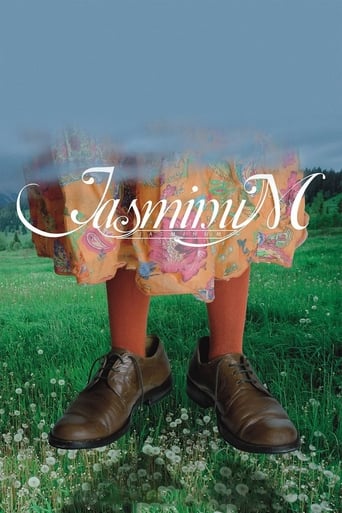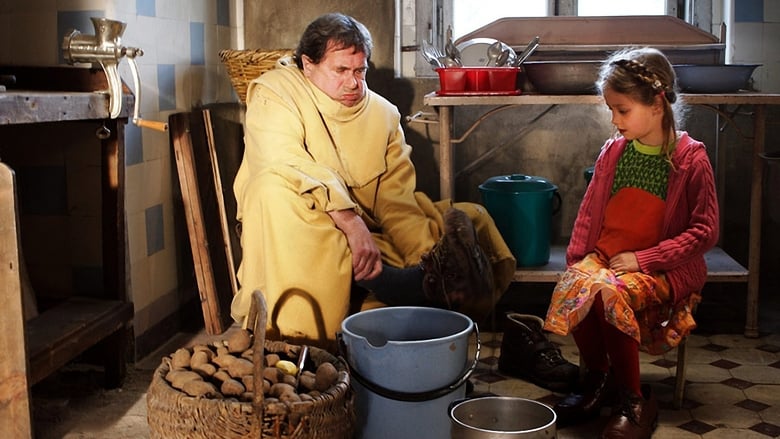

Jasminum (2006)
The peaceful world of a monastery, in a small town Jasmine, is destroyed by the arrival of monument restorers, Natasha, along with her daughter Eugenia. The legend associated with the monastery bode revelation in him a saint in the near future. Despite initial reluctance, Natasha starts the maintenance of the image stored there. The secrets of the monastery are unraveled: the unhappy lovers bodies placed in the catacombs, the secret elixir of love, created with the smell of the monks.
Watch Trailer
Cast


Similar titles
Reviews
I don't have all the words right now but this film is a work of art.
Absolutely Fantastic
A waste of 90 minutes of my life
The film's masterful storytelling did its job. The message was clear. No need to overdo.
It is my opinion that almost anyone who enjoys films would be interested in seeing Jasminum. Those who are acquainted with foreign cinema would especially enjoy it, as it is not the typical Hollywood film. There are no botched drug deals, car chases, or explosions, but a wealth of emotion and relation. The characters are original and well-developed and serve to supplement the main theme of the film, which is important when taking into consideration what constitutes good film-making universally. This is not just a good Polish film, but a good film in general. Kolski is a master director and warrants the praise he has received with his Jasminum, a beautiful and heartfelt film. This film's beauty stems from the characters and the way in which they interact and represent the main theme of the film: the importance of love and relationships. Jasminum is a 2006 release that tells the story of a monastery and its inhabitants. The primary focus of the film is on Brother Sanitas, the pious monastery cook, who lives a monotonous life without the comforts of material possession. Sanitas lives in the monastery with his fellow brothers, Birdcherry and Plum, who are also pious, religiously astute, and prone to bouts of silence as they strive to achieve spiritual perfection. They lead seemingly uneventful lives until an art restoration expert and her daughter pay a visit to the mundane monastery.The most meaningful and interesting aspects of Jasminum come to fruition upon the arrival of the art restoration expert, Natasha, and her five year-old daughter, Eugenia. Natasha has been employed by the monastery to try her hand at restoring an altar painting. Eugenia, who also serves as narrator of the film, is a cute, darling child who wins the heart of the solemn Sanitas. It is the interplay between these two characters that makes the film particularly interesting because Brother Sanitas has held the same routine for 13 years before the arrival of Natasha and Eugenia. Every morning, he feeds the animals, his fellow residents, and finally himself. Their time together represents the aforesaid primary theme of the film: how important love and relationships are in life. Both Eugenia and Sanitas both enjoy spending time together and look forward to what each day will bring in the company of one another, while at the same time understanding that not all relationships are able to last.The love and relationship theme permeates throughout the film, creating a web of relation that involves other characters as well, including Natasha, Brother Birdcherry, Patricia, and the actor Zeman. Through the art of manufacturing scents, memories are recalled and amorous relations are created. For instance, Patricia believes that there is no hope in establishing a relationship with the actor Zeman, who is self-centered, arrogant, and ignorant of her intentions. However, with the help of Natasha and of a special fragrance concocted from jasmine, among other scents, she is able to attract Zeman's attention. Viewers come to realize the importance of scent not only in the history of the characters, but also in the history of the monastery and its 1617 prophecy by Brother Barnabas. Scent functions as the strongest form of sensory stimulation and as a way to help people remember the past.
The film Jasminum made both positive and negative impressions, but overall was enjoyable to watch. The production is aesthetically very good, with attractive settings, music, and characters. It was often difficult to figure out what was happening and why, however, and the film's final message was somewhat ambiguous. Kolski's habitual style of "magical realism" was evident throughout the film, affecting the director's development of characters and backgrounds as well as theme.The fairy-tale-like atmosphere of this film entailed the use of characters who lacked any particular depth. Kolski's story did not delve much into the personal thoughts and developments of any individuals, focusing rather on their interactions as symbolic types. Most characters were used to represent particular feelings or aspects of the human character; they were symbolic types rather than developing beings. Patricia, the blond hairdresser, was portrayed as a somewhat shallow woman desperate for a partner, Sanitas as a monk simply following his orders and duty, and even Natasha's inner troubles were probed very little. The Father, also, did not act his part with any particular religious inspiration; nor did either of the brothers who were there together with Birdcherry.The monastic setting, too, seemed chosen primarily for its archaic and magical appeal, for the film was surprisingly devoid of religious expression given its overt placement in a monastery. This could be the director's active judgment on the worth of monastic life (as is hinted when all three of the brothers come out of their silence and admit they don't really know what they're doing there), but it is more likely that the monastery is simply used as a nice background for the various love stories with little religious connotation.These outward symbols clearly designate Jasminum as a fairy tale, but what the tale is actually about is more difficult to say. Part of what keeps the film interesting is that the viewer spends a good deal of time trying to figure out the plot and understand the message. One of the film's major themes was clearly related to love. Just what Kolski was trying to say about love was not entirely obvious, however, or at least one hopes that he had some deeper thoughts about love than those that came out most strongly. The intertwining of the ghostly Jasmine's love story with numerous subplots, her involvement with the monastery since its beginnings, and the sainting of Sanitas after he brought about her reunion with her lover all point to the centrality of her theme in which lovers are united despite great obstacles. The story of Patricia's infatuation with her actor was introduced rather late in the film, yet had become one of the central subplots by the end. In a sense her story is the central one, representing the triumph of love (so-called) that so many other characters desire. As such, Kolski paints a rather depressing picture of love. The actor, who was portrayed as a rude and unpleasant man, suddenly fell madly in love with the hairdresser after being exposed to the right perfume. Rather than treating this as a shallow love or allowing Patricia any sort of realizations about her lover's nature, the director uses the story of their union to parallel the true love epitomized in the "reunion" of the bodies of Jasmine and the original Birdcherry.While Brother Sanitas was portrayed as a good man, it was somewhat unclear why he was chosen to become a saint. Since general goodness did not seem to be valued so highly in this film as love, it seems likely that he was made a saint for his role in leading Natasha to Jasmine's body and thus causing the two dead lovers to be reunited.The best thing about this film in my opinion was its aesthetics: beautiful music, idyllic setting, and attractive characters. These traits make it appealing to audiences who enjoy a film as an artistic experience. The somewhat difficult plot may discourage viewers who don't want to expend a lot of effort to follow it. If one takes Jasminum's theme of love too seriously, it may come across as disappointingly fatalistic and shallow. Kolski's film is best appreciated as a fairy tale.
Jasminum is a mysterious film that explores the ideas and experiences of love, romance, and friendship in a religious, faith-based context. The viewer is swept back in time to the year 1619, where three mystifying and colorful coffins are housed in the crypt of a small monastery. The film is able to captivate the viewer by slowly explaining the mystery of the coffins and their inhabitants' strange scents clear through the end of the film which takes the setting to modern day Poland. Jasminum has the ability to hold on to the audience's attention because it does not reveal the explanations/answers all at once, but rather continuously builds upon itself as a masterfully crafted story. The audience feels right there beside the characters as they purse a journey of self-discovery while gaining an understanding of their own faith.The modern day characters, Genie and Natasha, bring a wonderful sense of joy and hope to the monastery and the local town. One cannot help but to smile at the sight of the narrator, little Genie. Genie's character offsets that of her mother's. Natasha seemed to be a strong willed woman with many curiosities of her own, struggling to find meaning in a life that has led her down an unknown, unplanned path. Meanwhile Genie stays relatively simple and true to her heart in the film. It is in this simplicity that the mystery is finally revealed. This film is sure to be interesting for viewers because of its brilliant plot and kind-hearted humor. Jasminum is a refreshing change in the history of Polish film. It is not gloomy and does not dwell on a rough past, but rather is colorful and insightful. Instead of portraying the problems and hardships of Polish life, like many famous Polish films of the past have done, Jasminum is more like a fairy tale exploring the brighter sides of the human experience. It may also rejuvenate one's Catholic faith.This film explores many earthly topics as well as those embedded in Catholicism. Such topics are desire, sense of belonging and duty, humility, and most of all love. Every character seeks to find his/her place in this world. This is an easy task for some, much harder for others. A hairdresser Patricia seeks a means to find herself a companion for she is convinced she cannot find it on personality and looks alone. She believes if she can harness the scent of Birdcherry any man could be hers. She epitomizes desire. Three monks, Birdcherry, Sweetcherry, and Plum, have an obligation to carryout their earthly duties in the hopes of performing a miracle, propelling them onto sainthood. They feel comfortable with this path, it is how they exemplify faith and it is what gives them strength and belonging. The audience learns later that Birdcherry and Natasha were once romantically connected in the past and this encounter has forced them both to reevaluate their responsibilities and purpose in life. Monk Sanitas is of course the lovable, and most of all humble cook. This character, if not any other, should be the most inspiring of the film. For thirty years he has been the cook and overall caretaker of the St. Roch Church. He lives the humble life that a monk is generally thought to live. He is innocent and compassionate, especially with Genie. By the close of the film, he wants nothing more than the girl to stay with him so he may play with her and watch little Genie grow up. He never forgets to ask for the Lord's blessing to watch over those in his heart. The last major theme of love may be attributed to Natasha; the chemist who finds out love is more about faith and feeling rather than scientific equations and experiments. Though one might believe to have all the explanations and reasons to life's questions and great mysteries, it is the nature of life and existence that keeps people guessing and searching. Sooner or later, if one has a pure, simple heart like Monk Sanitas or little Genie, life will be sure to reward. The characters that are most pure of heart and soul, like Monk Sanitas and little Genie, do not ask too many questions of God and therefore, do not question their purpose, their faith, and their abilities. On the other hand, those like Patricia are lost in a sea of doubt and unhappiness, that is until they reconnect with their faith, or at least something that give them faith. This film comes highly recommended to any person seeking a fresh outlook on the daily dilemmas they might encounter. Sometimes humans have a way of putting their lives into narrow perspectives containing too many explanations and diluted rationale. Jasminum helps viewers take that much needed step back, a breather. It helps one to understand life is much bigger than the individual while being grateful for the blessings they are granted. All age groups will learn something about themselves by viewing this film, and not only once, but every screening. This film will not put crazy ideas into one's head but rather a better understanding of what it is to be human in the world one lives in.
JasminumThe film is about love: primarily about love or love relationship between a man and a woman. The viewer is gradually introduced first to Patricia's unrequited love to the movie star, and as the story unfolds, also to Jasmina's tragic love story with one of the monks, and finally the unhappy love story of Natasza, the main character. And the movie is about love in a more general sense, or similar feelings between human beings: exemplified in the unusual friendship between the little girl Genia and Brat Zdrówko (Brother Sanitas), or Natasza's friendship with Patricia. Although the topic seems rather trite, "Jasminum" does a good job making it interesting by presenting it in the form of a fairytale for adults. The voice-over narration by a child and the waltz music mainly played by piano set the fairytale atmosphere. Jan Jakub Kolski, the director, obviously has a penchant for light, melodious but slightly sad waltz, as he made use of such music in his previous work "Pornografia (2003)." The difference is that in Pornografia the music is partially diegetic, while in "Jasminum" it is completely non-diegetic. This is because in "Pornografia" the music directly relates to the main character's tragic past. In "Jasminum," on the other hand, the waltz mostly accompanies the young narrator's voice-over, helping to set the atmosphere: tragicomic, sad and comforting at the same time. When doing so, the music also functions as a separator between stages of the plot development, or a symbolic "curtain" between "acts" of the film. As in "Pornografia," tragic love story and secrets from the past are important in Jasminum. The monastery itself holds a tragic love story from the past, and its spell still persists. The spatial setting of a monastery is quite adequate in this context because by definition the setting must separate men and women. Natasza, the altar-painting restorer and perfume maker on the side, turns out to have her own unhappy love story, no matter how absurd: a runaway bridegroom. Patricia, the hairdresser whom Natasza helps, has perhaps the most banal kind of sad love story: unrequited love towards a famous actor. The film, however, treats all of these love stories equally with "a sense of humor and attentiveness" as the director emphasizes in one of the interviews.The precocious narrator Genia is the only person who does not have a tragic love story hidden in the past for obvious reasons. Therefore her narration of the story is fairly objective, with her adorable dryness adding to the humorous aspect. In the end, however, Genia experiences her own version of a sad love story when she must leave Brat Zdrówko.The key to solving all the mysteries of love lies in finding the right aroma. The film is all about magical smell. This extraordinary idea also adds to the fairytale aspect of the film. The important fact is that Natasza's magic perfume works as a love potion only because the love is already there. She merely gives a little boost by caring and acting upon her sympathy. This leads to the final topic of the film: "saintliness," as the director comments.The film's message is that the most important thing between people is love and caring, and acting upon one's caring for another person. When the caring and acting reaches a certain level, it qualifies to be saintliness. The final scene, when Brat Zdrówko becomes a saint, confirms this idea. As the viewers saw in the film, Brat Zdrówko is the one who cares the most, even about the piglets; he is the one who acts the most to take care of the entire monastery, silently and inconspicuously. This final message is conveyed again with "a sense of humor and tender attentiveness" as Zdrówko complains he cannot light the stoves with the stigmata his hands.














